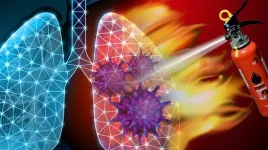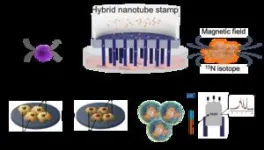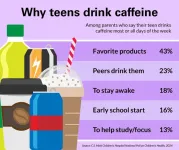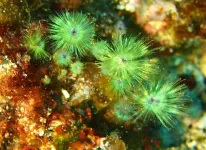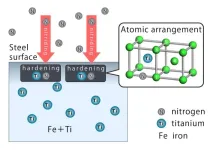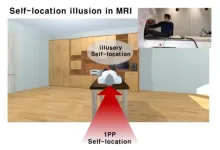(Press-News.org) In some severe cases of COVID-19, the lungs undergo extreme damage, resulting in a range of life-threatening conditions like pneumonia, inflammation, and acute respiratory distress syndrome. The root cause of those wide-ranging reactions in the lungs has until now remained unclear.
A new study by researchers at Columbia and the Columbia University Irving Medical Center sheds light on this mystery. The study found that ferroptosis, a form of cell death first named and identified at Columbia in 2012, is the major cell death mechanism that underlies COVID-19 lung disease. The finding indicates that deliberately halting ferroptosis with therapeutic drug candidates could improve COVID-19 outcomes.
“This finding adds crucial insight to our understanding of how COVID-19 affects the body that will significantly improve our ability to fight life-threatening cases of the disease,” said professor Brent Stockwell, one of the study’s lead authors.
Ferroptosis was first reported by professor Stockwell in 2012. Ferroptosis is an unusual form of cell death in which certain cells die because their outer fat layers collapse. It differs from the most common kind of cell death, which occurs both in disease contexts and in normal processes like aging and involves cells chopping up the molecules in their interior.
Since proposing the concept of ferroptosis, Stockwell’s lab has demonstrated that it is instrumental to normal bodily processes, but that it can also attack and kill healthy cells in patients with neurodegenerative diseases like Parkinson’s, Alzheimer’s, and Lou Gehrig’s disease.
Though ferroptosis can be destructive, recent studies indicate that it could also be harnessed for good. Intentionally inducing ferroptosis could counteract diseases like cancer where rampant cell growth is dangerously occurring. The ability to inhibit ferroptosis, on the other hand, could offer doctors new ways of combating cell death that should not be occurring, as in the case of COVID-19 lung disease.
“We’re hopeful that these important new findings could improve our ability to confront this pernicious disease, which, in too many cases, still diminishes health outcomes and results in death,” Stockwell said.
END
Study offers new detail on how COVID-19 affects the lungs
2024-05-20
ELSE PRESS RELEASES FROM THIS DATE:
Body’s ‘message in a bottle’ delivers targeted cancer treatment
2024-05-20
Researchers at Karolinska Institutet in Sweden have succeeded in delivering targeted cancer treatment via small membrane bubbles that our cells use to communicate. A new study published in Nature Biomedical Engineering shows that the treatment reduces tumour growth and improves survival in mice.
When our cells communicate, they send out small membrane bubbles known as extracellular vesicles which contain various signalling molecules. Interest in these tiny bubbles, sometimes referred to as the body’s ...
1 in 4 parents say their teen consumes caffeine daily or nearly every day
2024-05-20
ANN ARBOR, Mich. – A quarter of parents report that caffeine is basically part of their teen’s daily life, according to a national poll.
Two in three parents think they know whether their teen’s caffeine intake is appropriate and which products have too much caffeine. Yet a third aren’t able to identify recommended caffeine limits, according to the University of Michigan Health C.S. Mott Children’s Hospital National Poll on Children’s Health.
“Our report suggests parents may not always be aware of how much they should be limiting caffeine consumption for teens,” said poll co-director and Mott ...
What makes some brown algae shimmer and others not?
2024-05-20
Compartments of consistently sized, tightly packed microspheres are what makes some brown algae shimmer like opal. The Kobe University discovery not only sheds light on the mechanism behind the alga’s structural coloration, it is also the first to spot the effect in an order of brown algae other than the two where it was known to occur.
Most brown algae are indeed yellowish-brown, but scuba divers noticed that a species resembling Sporochnus in the order Sporochnales shimmers like peacock feathers in yellow, ...
Seeking stronger steel, systematic look at 120 combinations of alloy elements provides clues
2024-05-20
Decarbonization of automobiles not only requires a shift from gasoline engines to electric motors, but also quality steel parts that help the motors run while lessening the weight of vehicles. High-performance steel materials can offer quieter rides and resist the wear and tear from high-speed rotation in motors. To create them, the process of modifying the steel surface with carbon, nitrogen, and alloy elements needs to be optimized.
To understand the interactions between elements in steel, a systematic investigation ...
Tricking the Brain’s inner GPS: Grid cells responses to the illusion of self-location
2024-05-20
Dr. Hyuk-June Moon from the Bionics Research Center at the Korea Institute of Science and Technology (KIST), in collaboration with Prof. Olaf Blanke’s team at the Swiss Federal Institute of Technology Lausanne (EPFL), has successfully induced self-location illusions with multi-sensory virtual reality (VR) in the MRI scanner and observed corresponding changes in the human brain's grid cell activity.
The brain is known to contain grid cells and place cells, which perform global positioning system (GPS) functions that allow us to recognize where we are. While ...
Gallbladder cancer rises among Black Americans as cases decline in other groups
2024-05-20
WASHINGTON, DC (May 20, 2024) — Gallbladder cancer rates have been stable or declining for most Americans over the last two decades, but cases have steadily risen among Blacks, with growing numbers not being diagnosed until later stages, according to a study scheduled for presentation at Digestive Disease Week® (DDW) 2024.
“Gallbladder cancer diagnosis at late stage can be highly detrimental,” said lead author Yazan Abboud, MD, internal medicine resident at Rutgers University New Jersey Medical School. “This could be due to a lack of timely ...
Biomarker for gastric cancer and other cancer studies set for digestive disease week
2024-05-20
Washington (May 14, 2024) — Cancer-related studies, including a diagnostic tool for gastric cancer and trends in gallbladder and colorectal cancers, will be presented this week at Digestive Disease Week (DDW) 2024. Abstracts are available to registered media, and press releases are available where noted. Studies are embargoed until 12:01 a.m. EDT the day of presentation, unless otherwise noted.
Here are summaries of the new research on the schedule:
Oral microbiome signatures as potential biomarkers for gastric cancer risk assessment, Abstract 949, will be presented Monday, May 20, at 4:15 p.m. EDT. (A press release is available upon request. Embargoed until 12:01 a.m. EDT ...
Endoscopic studies presented at Digestive Disease Week
2024-05-20
Washington (May 14, 2024) — Studies featuring endoscopic and laparoscopic procedures, including patient views on artificial intelligence in endoscopy and hazards to healthcare personnel of smoke-producing procedures, will be presented this week at Digestive Disease Week (DDW) 2024. Abstracts are available to registered media, and press releases are available where noted. Research is embargoed until 12:01 a.m. EDT the day of presentation, unless otherwise noted.
Here are summaries of the new research:
Patients’ sentiments ...
Hunger hormone, antibiotic-induced weight gain, and sleep and digestive health explored at Digestive Disease Week
2024-05-20
Washington (May 14, 2024) — Studies exploring the hunger hormone, weight-loss drugs, sauerkraut and antibiotic weight gain, the impact of physician gender on care, and the relationship between sleep patterns and digestive diseases will be presented this week at Digestive Disease Week (DDW) 2024. Abstracts are available to registered media. Embargos lift at 12:01 a.m. EDT on the day they are presented unless otherwise noted.
Here are summaries of the new research:
Performance of a machine-learning gene ...
Innovative 3D printing could revolutionise treatment for cataracts and other eye conditions
2024-05-20
Peer-reviewed – Proof-of-concept study
University of East Anglia researchers have made a significant breakthrough in ocular device technology with the introduction of a novel resin for 3D printing intraocular devices. This innovation has potential to enhance the manufacture of eye implants universally used in cataract and refractive surgeries.
An artificial intraocular lens (IOL) is primarily required for people with cataracts, a condition where the eye’s natural lens becomes cloudy, obscuring vision.
They can also be also used to correct refractive errors such as myopia (nearsightedness), ...
